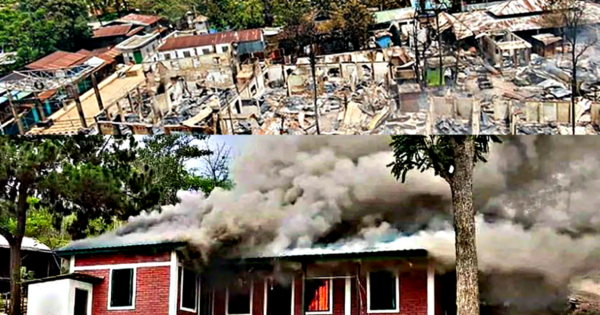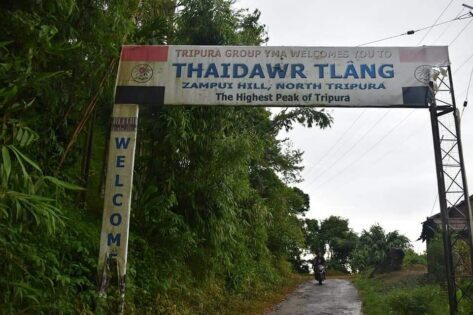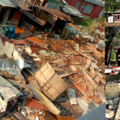Insurgency in Manipur and Demand for a Separate Kuki Homeland

Amid the violence in Manipur, a Press Statement was issued by 10 Kuki-Chin MLAs raising the allegation that the violence was unleashed upon the Chin-Kuki-Mizo-Zomi tribal groups by the majority Meitei community, tacitly supported by the Government. The political aspiration of separation from Manipur harboured by these communities since a long time is now being used by the Kuki political leaders to seek a ‘Separate Administration’ under the Constitution of India – a separate Kuki homeland. But, amidst all these, it is the Meitei Hindu community who is on the brink of losing its identity, culture and civilisation. On every front, Hindu Dharma is losing way to Adharma in not just Manipur but almost the entire North-East.
With their declining numbers almost every passing decade, the Meiteis have been pushed towards further annihilation as a result of the recent spate of violence. In this context, the agenda for establishing a separate Kuki-Zomi homeland or ‘Greater Mizoram’ needs to be analysed further. Known by several other names such as Zoram, Zale’n-gam or ‘The Land of Freedom’, etc. the political imagination of a separate Kuki and Zomi homeland with a concrete territory dates back to the late 1980s and the early 1990s when the first and the largest of all the Kuki-Zomi insurgent groups – the Kuki National Organisation (KNO) – came into being.
The demand has surfaced periodically ever since. The recent violence has seen the resurfacing of the demand for a separate Kuki administration. It needs to be mentioned here that on June 23, the All Assam Manipuri Youths’ Association (AAMYA) had announced the imposition of an indefinite economic blockade on NH-54, the vital road connecting Assam with Mizoram, on the ground that the Mizo National Front (MNF) publicly declares its withdrawal of support for the demand of a separate administration for the Kuki-Chin-Zomi people, with a view to ensuring regional peace and maintaining Manipur’s territorial integrity.
We must not forget that the MNF to which the current Chief Minister of Mizoram Zoramthanga is affiliated, fought for an Independent ‘Greater Mizoram’ that eventually ended in bloodshed in 1984. The idea of a separate Kuki-Zomi homeland emerges from the belief that the hill areas of Manipur, adjoining Mizoram and Myanmar, is inhabited by the Zo community who share affinity of ancestry, religious and cultural belief systems, etc. with the Mizos. In fact, the term ‘Zale’n-gam’ was initially coined to give shape to the idea of the establishment of a separate Kuki and Zomi homeland. Well, is this demand going to fructify anytime soon? We certainly cannot overlook the threat associated with the same.
The declaration by the 10 Kuki MLAs of Manipur for a separate administrative arrangement and their demand for separation from Manipur is nothing but a step forward in somehow realising their separate political aspiration of a Christian Zo nation and establishment of Mizo hegemony. This has every potential for the outbreak of another round of conflict with the Kuki-Chin-Mizo group. The demand for a separate Kuki administration had subsided following peace negotiations between the Kuki National Organisation (KNO) and the Zomi Revolutionary Army (ZRA), both based in Myanmar, with the Government of India under the SoO pact. KNO chief PS Haokip, a Kuki, was born in Myanmar and raised in Nagaland.
Both the KNO and the ZRA also seek self-determination for the Kuki-Chin-Zo people in the form of ‘Zale’n-gam’ – a defined territory passing through Manipur, Nagaland, Mizoram, Assam, Bangladesh, and Myanmar. Various Kuki civil society organisations and their armed outfits claim 12,958 sq. km, which is more than 60% of Manipur’s 22,000 sq. km area to be incorporated in the separate Christian Zo nation or ‘Greater Mizoram’. This region encompasses the Sadar Hills area surrounding the Imphal Valley on three sides, the Kuki-dominated district of Churachandpur, Chandel district (having a mix of Kuki and Naga populations), and even a few parts of the Naga-dominated Tamenglong and Ukhrul districts.
The entire state of Mizoram is also included as a part of this imaginary Kuki-Zomi homeland. Besides, they even aspire to include the Chittagong Hill Tracts of Bangladesh, and the Chin and Sagaing Divisions of Myanmar. But, the right to self-determination cannot be gained by scuttling the rights and freedoms of other communities. According to the Kuki-Zomi separate homeland narrative, those areas of the North-East inhabited by the Kuki-Chin-Zo community are not yet a part of the Union of India. Hence, unlike the Naga demand for a separate country of Nagalim, the Kukis have sought a separate state for themselves within the Indian Union.
In the year 2012, influenced by the demand for a separate state of Telangana, an organisation called the Kuki State Demand Committee (KSDC) was formed, which soon led the movement for a separate Kuki homeland in the North-East. In Manipur, most of the strikes, bandhs and economic blockades that are declared with the objective of not permitting goods enter the Imphal Valley, have been a regular affair on the part of the KSDC since the time of its formation. According to the KSDC and sections of the Kuki-Zomi community, after the defeat of the King of Manipur in the 1891 Anglo-Manipur War, the Kingdom of Manipur became a British Protectorate.
However, the lands of the Kuki-Zomis were not a part of this Agreement. In their opinion, the Kuki Zale’n-gam sprawled across a large part of India’s North-East and contiguous areas in present-day Myanmar. Under the Treaty of 1834, the British handed over a significant chunk of this land to Burma so as to appease the Burmese King of Ava. The KNO has argued that the Zale’n-gam included the area upto the Chindwin river in Myanmar. It covered the bordering regions of India in the North-East, the areas around the Nantalit river in Northern Myanmar, and stretched to the hilly and rugged terrain of Myanmar’s Chin state in the South.
In India, the Kuki homeland included the hill districts of Manipur, including the Naga areas; Kanjang, Akhen, Phek, and parts of Dimapur in Nagaland; Karbi Anglong, North Cachar hills, and Haflong in Assam; Tripura, and as well as parts of the Chittagong Hill Tracts in Bangladesh. Over the years though, this imagination of the Kuki homeland has shrunk to that of a state carved out of the hill areas of Manipur, including those dominated by the Naga communities. Some Kuki groups believe that a separate Kuki homeland would provide them with political power and control over their “own” resources which are, at present, largely controlled by the Meiteis.
This would allow them to achieve overall socio-economic development. The Kukis have also alleged that Naga insurgent groups have been attempting to grab Kuki lands for several decades now. Kuki organisations also argue that a separate state would enable them to make decisions on matters related to governance, law and order, etc. based on their specific needs and aspirations. The unregulated influx of Kukis from Myanmar to Manipur and other states of the North-East thus stinks of a devious plan to divide and destabilise Bharat. Historically speaking, the Kukis have been the main perpetrators of several conflicts in Manipur earlier as well.
Ethnic cleansing of the Nagas and the Tamil Hindus from the Indo-Myanmar border town of Moreh in the year 1995 was a pre-planned agenda of the Kukis, all with the objective of increasing their presence in the area, both socio-politically and culturally. After the fierce Kuki-Naga feuds of the early 1990s, the Kukis took over control of Moreh and forced the Nagas out. Earlier, the Nagas dominated many parts of the highway that connects Moreh with Imphal, but today there is hardly any Naga population left in Moreh. The Tamils of Moreh have been the victims of extortion in the hands of the Kuki militants belonging to the Kuki National Army (KNA).
In 1995, the Kukis kidnapped a Tamil businessman from Moreh and held him hostage in the nearby village of Chang Vangphei. The trader was eventually killed because the Tamils refused to pay the tax. This sparked off bloody riots between the Tamil Hindus and the Christian Kukis. But, the Kukis found that the Tamils, who were in possession of arms for their personal safety, could not be so easily made to accept their demands. So, peace prevailed and the KNA was compelled to cut down on its extortion-related activities in Moreh. In other parts of the North-East too, unabated immigration of the Kuki-Chins from Myanmar has led to the ethnic cleansing of several native communities from many areas.
The Jampui Hills District of North Tripura is a very good example of this. The area has become Christian majority at present primarily because of illegal immigration, leading the original settlers, i.e. the Hindu Reangs, Chakmas, and Hajongs, to move out to other safer Hindu-dominated locations. A temple of Mahadev situated at a place called Behling Shiv in the Jampui Hills was destroyed by Christian Mizo and Kuki groups in the year 1997. Behling Shiv was renamed as Betlingchhip with the objective of whitewashing the glorious Hindu cultural and civilisational heritage of this area and thereby re-write its history in due course of time.

The above photograph is from the writer’s personal collection
British records (specifically The Imperial Gazeteer of India: Volume IV by William Winson Hunter) have clearly mentioned the name of this place as Betling Sib. Sibraikhong, the highest mountain peak of Tripura, derives its name from Sibrai – considered to be the supreme Devata of the Reangs equated with Shiva. After the destruction of the Shiva temple, Christians had planted crosses in different places of the sacred Jampui Hills area and also renamed the Sibraikhong peak as Thaidawr Tlang. In Manipur, the Meiteis have always been on the losing side. The Christian tribal population of Manipur is taking advantage of the increasing isolation of the Meiteis by torturing them in whatever way they can.
The ambitious Imphal-Jiribam Railway Project consisting of a total 11 major and 137 minor bridges is a very good example of this. Well, let us see how militancy has been a major hindrance in this regard. The world’s tallest pier railway bridge with its pillars rising to a height of 141 metres near Khumji over the valley of the Ijai river near Manipur’s Noney district is a part of this crucial connectivity Project. Building an Indian Railways network that reaches and connects the ‘Seven Sisters’ of the North-East has always been a challenging and daunting task against the extremities of nature. Yet, however, to be able to build the world’s tallest railway bridge in the Himalayan ranges is a truly remarkable feat.
In fact, some of the best international practices are being used for the construction of this extremely important bridge that has been designed to take a maximum train speed of 120 kmph. The bridge will also help in crucial freight movement. As per the Indian Railways, the bridge can carry upto 25 ton axle-load freight containers as well. Moreover, since it is situated in Seismic Zone-V, all precautions, particularly the development of a site-specific design spectrum, have been taken to ensure long-term stability of the bridge. State-of-the-art techniques have been made use of to check landslides due to heavy rains and earthquakes.
The general soil profile of this region is shale which is touted to be undesirable for the construction of bridges of this magnitude. Studies have also been conducted to analyse the stability and safety of the bridge under the maximum design wind speed of 241 kmph and the bridge is being built accordingly. Because of the continuous threat of militants, the bridge will be provided 24*7 security cover with personnel posted exclusively at the site. Additionally, surveillance of the bridge through CCTVs and remote monitoring by different high-end technical instruments is also being considered to ensure its safety.
To recall, the North-East Frontier Railway started construction on the Imphal-Jiribam Railway back in the year 2008 when it was officially sanctioned. It is a broad gauge railway track linking the town of Jiribam in the westernmost corner of Manipur adjoining Cachar district of Southern Assam in the Barak Valley to Manipur’s capital city Imphal, covering a distance of around 220km. At present, the route from Imphal to Jiribam consists of 9 railway stations, Jiribam, Noney, and Imphal being the major ones. However, the new line will have 11 railway stations spanning over 5 districts, ensuring efficient operation of the railway services.
The massive 111-km long Project was initially supposed to be completed by March, 2020 with a potential to cover 100km/hr. Its construction is in the advanced stages of completion and now expected to be completed by December, 2023. After its completion, Imphal will become the fourth capital city in the North-East to have a rail link with the rest of the country via Silchar, Haflong, Lumding, and Guwahati, thereby drastically reducing the time of an exhausting road journey of 11-12 hours from Jiribam to Imphal to just 2.5 hours. Assam’s Guwahati city adjoining the state capital Dispur, Tripura’s capital city Agartala, and Arunachal Pradesh’s Naharlagun adjoining the capital city of Itanagar are already on the rail network.
A huge chunk of manpower consisting of engineers, technicians, mechanics, and labourers has been engaged in the construction of this Project over tough, inhospitable mountainous terrain. It passes through steep rolling hills of the Patkai region in the lower reaches of the Himalayas, traversing through a number of deep gorges, valleys and several rivers flowing at low ground levels. The larger objective behind the Imphal-Jiribam Railway Project is to connect all state capitals of India with the North-East and also ensuring connectivity with the Trans-Asian Railway network in the near future. It also aims to connect Kolkata to Kunming via Dhaka and Imphal to Mandalay in Myanmar.
The Project has its own economic and strategic significance for not just the North-East but the rest of Bharat too. It will help India in its defence and military operations to counter the influence of China over Myanmar and the South-East Asian continent. In fact, the Indian Government is dealing with this Project strategically to strengthen trade and commercial relations with South-East Asia. Manipur being a landlocked state, upon completion, the Project will improve connectivity and bring in economic prosperity by making transportation and communication much more simple and easy, especially for people residing in the Imphal Valley area.
Political stability in the North-East and Government patronage to railway projects such as these are therefore important for all the routes to become fully functional soon. The Project has been delayed mainly because of negligence on the part of both the State and the Central Governments. Logistical hindrances and bad weather induced by heavy monsoon rains and the accompanying floods and massive landslides that take place annually have obstructed this Project time and again. The construction work has also been frequently disturbed by the presence of Church-funded militant outfits in the region. Many engineers involved in this Project have been shot, kidnapped and killed by unknown miscreants.
On the evening of December 20, 2016 an NF Railway engineer from West Bengal working as a project manager in the Imphal-Jiribam Railway Project and supervising the construction work of a bridge-tunnel, was abducted by a group of unidentified armed persons from the work site in Manipur’s Makru area of Tamenglong district. Several other workers were also thrashed by the armed group to create a situation of panic. Although the site of the incident was protected by personnel of the 5th Manipur Rifles and the nearest CRPF post was informed about the matter immediately after the group left, but they arrived at the site only the following day.
The presence of several militant organisations in Manipur and its neighbouring regions is a major security concern for the site engineers in the form of frequent threat calls and messages, attacks, firing, and kidnapping for ransom. Most of those who are kidnapped are staff of the private contractors and not always railway officials. Outsiders visiting the area are provided armed escorts and always advised to move in groups. As a result of these and several other such criminal cases of abduction of railway workers, supervisors, and engineers from the project sites, panicked workers flee these places to return as and when adequate security cover is being provided to them.
Although the workers have been trying their best to complete the Project soon, but this has been one among the major factors causing delay of infrastructure projects in the North-East. The Government is doing its part by deploying security forces along the strategic locations so as to ensure the safety and security of the workforce here and as well as the assets. In fact, the Centre is placing a special thrust upon improving rail connectivity in these neglected areas of the North-East. At the Project site, more than thousands of security personnel from across the security forces, including Assam Rifles, Manipur Rifles, Indian Reserve Battalion, State Police, and the Railway Police Force are present.
But, it is also very important that the local people of the area and other social organisations support and lend their helping hand to everyone involved in these Projects. In this context, the Zo nation theory and the demand for regional or territorial autonomy in the form of a separate Kuki homeland should be reviewed and investigated by the Government as it poses a serious threat to India’s national security. Moreover, appropriate inquiry is a must with regard to the suspicious role of evangelical forces in Manipur in the present situation of violence. The common public of India must know the reality behind this violence so that they are able to distinguish clearly the perpetrators from the victims.
Disclaimer: The facts and views expressed here are solely of the author. My India My Glory does not assume any responsibility for the validity or information or images shared in this article by the author.
Featured image courtesy: Jayalakshmi Chanu and Babeena Laishram.
Dr Ankita Dutta
Latest posts by Dr Ankita Dutta (see all)
- Sakti Worship in North-East India: Historical, Cultural Perspective - October 23, 2024
- Insurgency in Manipur and Demand for a Separate Kuki Homeland - October 23, 2024
- Manipur Crisis: Exodus of Manipuri Hindus from Their Homeland? - October 23, 2024






